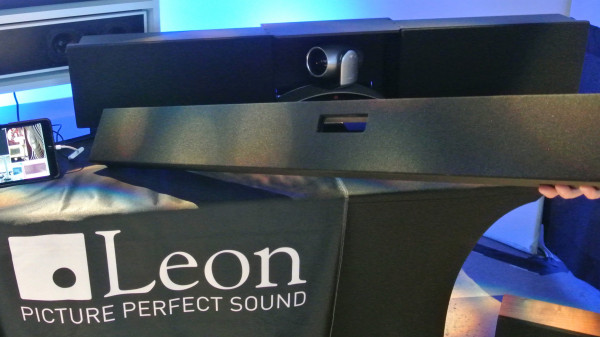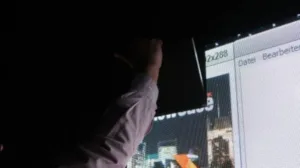On November 4, NEC’s professional A/V division mounted its New York ShowCase to give its partners a chance to show their wares. The event was held at SIR Stage 37, a 37th-street exhibition venue on New York’s far west side. The block is still gritty, but since it’s near the Hudson Yards gentrification area, its gritty days are probably numbered.

Image:Ken Werner – Click on image for high resolution, multiple image version.At a showcase such as this one, you expect to find products such as new signage software, media players, multi-panel controllers, new variations on motorized screens, and perhaps a new flat-panel mount or two. And at the NEC event, you would not have been disappointed. But there were also a few display hardware surprises, so lets talk about those.
Most interesting was modular LED signage being developed for NEC by S[quadrat], a german designer of large-scale display and lighting systems. Sales and marketing director Andreas Brockschmidt showed me that the LEDs and their interconnects were on a “front-surface” module that connected magnetically to a structural backplane that provide power and the video signal. The modules will be available in 1.5-, 1.9-, 2.3-, and 3.8-mm pitch. A module of any pitch can replace any other in any location, with the controller automatically making the needed adjustments, and the modules are hot-swappable!
NEC has been known as a supplier of LCD signage and projection, but now that the pitch of LED modules is approaching the pixel pitch of early plasma TV sets, the range of applications is increasing, and image quality is now appealing at relatively short viewing distances. Presumably NEC didn’t want to lose business when a customer wanted LEDs as part of his mix, but it would be hard to think of anything really new in the conventional LED sign business except for further decreases in pixel pitch and, hopefully, price. But, thanks to S[quadrant], NEC will be able to enter this competitive market* with genuinely innovative products that make field replacement and upgrading of modules much simpler than they’ve been in the past.
On the projection side, Da-Lite was showing its new Parallax ambient-light screen material, which, said regional sales manager Joe Davis, is a somewhat modified version of a technology that was developed by Dainippon Printing and which has been available from DNP. The multilayered screen contains films that block and absorb light, but the key is layers contain prism-like patterns that reflect light entering from significantly off-axis directions, but accept light from the direction of the projector. Different versions are availabe for standard-throw and ultra-short-throw projectors.
The Parallax material is available in heights up to 60 inches and is unlimited in width, said Davis. That would give you a 123-inch (3.12m) diagonal screen in 16:9 according to my calculations.
Steve Cook, National AV Consultant Manager for Da-Lite competitor Draper, said his company OEM’d the DNP material for a while, but discontinued carrying it. Although its ambient-light rejection and deep blacks are excellent, he said, the 60-inch height limitation and stiffness relative to other materials posed difficulties for Draper and many of its customers. Draper’s premium screen material is called TecVision, is ISF certified for color accuracy, and is compatible with 4K images. The prismatic-structures in DNP and Da-Lite materials are too large to support 4K, although they are fine for FHD, Cook and Davis both said.
Finally, Leon Speakers was showing a sound bar with integrated camera for video conferencing and similar applications. The concept, said Commercial Sales and Marketing Director Michael Fencil, is to create a natural environment in which the sound and image originate in the same place. The user will naturally direct his or her attention in that direction, and will then automatically be looking into the camera. This provides a very natural kind of communication, in which both participants in the conversation appear to be addressing each other directly, said Fencil.
 Leon sound bar – Image: Ken Werner
Leon sound bar – Image: Ken Werner
Fencil noted that Leon Speakers invented the sound bar, and in the days before the sound bar became a high-volume consumer product, people would order one by asking for “a Leon.”
I didn’t know that.
– Ken Werner
*NEC in Europe (and MEA) has been selling LED displays for some time and has some prestigious installations including the Odeon, Leicester Square, in London. Up to now, they have mainly been in larger pitch and external applications. (BR)
Ken Werner is Principal of Nutmeg Consultants, specializing in the display industry, manufacturing, technology, and applications, including mobile devices and television. He consults for attorneys, investment analysts, and companies using displays in their products. You can reach him at [email protected].

